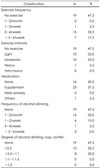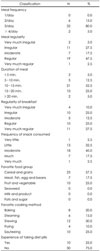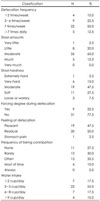Abstract
The purpose of this study was to evaluate the effects of routine haecho bibimbab (boiled rice with assorted seaweed mixtures) consumption on the bowel habits in humans. Forty free-living adults (female 38, male 2) participated in this study (mean age 41.2 ± 7.5). After a baseline survey on general characteristics, life style and dietary habits, the participants were asked to consume haecho bibimbab during two-week period for lunch. Habitual bowel movements were checked out every day by a questionnaire and nutrient intake was estimated by a 24-hour recalls before and after the study. After 2 weeks of clinical trial, the bowel habits had improved. Haecho bibimbab increased the number of bowel movements, changed hard stools into softer ones. It also lessen the sense of incomplete evacuation, and abdominal pain during defecation, increased water intake (p < 0.001) and improved gastrointestinal problem. The participants believed that haecho bibimbab was effective in improving their constipation symptoms and bowel habits (p < 0.01). Routine haecho bibimbab consumption tended to increase especially vitamin A, E and folate intake (p < 0.01). The present findings suggest that routine seaweed-based lunch meal (haecho bibimbab) consumption may improve bowel habits without side effects.
Figures and Tables
Table 6
Changes in habitual bowel movement of the subjects before and after feeding haecho bibimbab for 2 weeks (N = 40)

Table 7
Changes in habitual bowel movement of the subjects before and after feeding haecho bibimbab for 2 weeks (N = 40)

References
1. Higgins PD, Johanson JF. Epidemiology of constipation in North America: A systematic review. Am J Gastroenterol. 2004. 99(4):750–759.

2. Jun DW, Park HY, Lee OY, Lee HL, Yoon BC, Choi HS, Hahm JS, Lee MH, Lee DH, Kee CS. A population-based study on bowel habits in a Korean community: prevalence of functional constipation and self-reported constipation. Dig Dis Sci. 2006. 51(8):1471–1477.

3. Lee HC, Hong SN, Lee JH, Lee SY, Son HJ, Kin YH, Rhee PL, Kim JJ, Rhee JC, Choi KW, Kim HJ, Lee WY, Chun HK. Clinical features and functional outcome of the patients with idiopathic chronic constipation who underwent surgical treatment. Korean J Gastrointest Motil. 2001. 7(2):204–215.
4. Song CW. Diagnosis and management of chronic constipation. J Korean Acad Fam Med. 2003. 24(12):1069–1077.
5. Camilleri M. Review article: tegaserod. Aliment Pharmacol Ther. 2001. 15(3):277–289.
6. Nam KH, Sohn SK. Clinical results of subtotal colectomy in chronic constipation patients. J Korean Soc Coloproctol. 2000. 16(6):395–401.
7. Kim MH. A study of nutritional effect in dietary fiber. Journal of Industrial Development. 1997. 5:95–109.
8. Chen HL, Haack VS, Janecky CW, Vollendorf NW, Marlett JA. Mechanisms by which wheat bran and oat bran increase stool weight in humans. Am J Clin Nutr. 1998. 68(3):711–719.

9. Lee MC, Kim YS, Youn SW, Lee JG, Kim MY, Shin CH, Han KS, Choi CS. The surveys of functional high dietary fiber rice supplement on constipation, dietary preferences and eating behavior in competitive athletes. J Coaching Dev. 2004. 6(2):133–148.
10. Kim JY, Kim OY, Yoo HJ, Kim TI, Kim WH, Yoon YD, Lee JH. Effects of fiber supplements on functional constipation. Korean J Nutr. 2006. 39(1):35–43.
11. Kim TI, Park SJ, Choi CH, Lee SK, Kim WH. Effect of ear mushroom (Auricularia) on functional constipation. Korean J Gastroenterol. 2004. 44(1):34–41.
12. Huh JW, Park YA, Sohn SK, Lee SM, Jung EJ, Lee KY, Kim SJ, Ha WK. Effect of yogurt enriched water-soluble fiber on functional constipation. J Korean Soc Coloproctol. 2007. 23(5):312–320.

13. Kuda T, Fujii Shaheki T, Hasegawa A, Okuzumi M. Effects of brown algae on faecal flora of rats. Nippon Nogeikagaku Kaishi. 1992. 58(2):307–314.

14. Cho YJ, Lee KW, Kim YY, Kim GB. Studies on physicochemical and biological properties of depolymerized alginate from sea tangle, Laminaria japonicus by thermal decomposition. J Korean Fish Soc. 2000. 33(5):388–392.
15. Madsen JL. Effects of gender, age, and body mass index on gastrointestinal transit times. Dig Dis Sci. 1992. 37(10):1548–1553.

16. Park IS, Lee HR, Lee SI, Kim KW, Lee SM, Cho JS, Park HJ, Choi JY, Cho HS. Contribution factors of colonic transit time in normal adults. Korean J Gastroenterol. 1999. 34(3):330–337.
17. Hata Y, Nakajima K, Uchida JI, Hidaka H, Nakano T. Clinical effects of brown seaweed, Undaria pinnatifida (wakame), on blood pressure in hypertensive subjects. J Clin Biochem Nutr. 2001. 30:43–53.

18. Wong KH, Sam SW, Cheung PCK, Ang PO. Changes in lipid profiles of rats fed with seaweed-based diets. Nutr Res. 1999. 19(10):1519–1527.

19. Ara J, Sultana V, Qasim R, Ahmad VU. Hypolipidaemic activity of seaweed from Karachi coast. Phytother Res. 2002. 16(5):479–483.

20. Kim MS, Kim JY, Choi WH, Lee SS. Effects of seaweed supplementation on blood glucose concentration, lipid profile, and antioxidant enzyme activities in patients with type 2 diabetes mellitus. Nutr Res Pract. 2008. 2(2):62–67.

21. Simrén Magnus. Physical activity and the gastrointestinal tract. Eur J Gastroenterol Hepatol. 2002. 14(10):1053–1056.

22. Choi JY. Effects of a constipation intervention program on inpatients' defecation. J Korean Acad Nurs. 2004. 34(1):72–80.

23. Chung HJ, Park HW, Choi EJ, Lee JJ. A study of the lifestyle factors related to constipation among food habits of college students in Seoul and Gyunggi. Korean J Community Nutr. 2002. 7(5):654–663.
24. Lee KH. Etiology and treatment of the constipation. Kyung Hee Univ Med J. 1999. 15(4):328–332.
25. Lee SC. Clinical evaluation about RLQ pain secondary to chronic constipation (or fecal impaction)-About DDx from acute appendicitis. J Korean Surg Soc. 1997. 53(2):192–197.
26. Pare P, Ferrazzi S, Thompson WG, Irvine EF, Rance L. An epidemiological survey of constipation in Canada: Definitions, fates, demographics and predictors of health care seeking. Am J Gastroenterol. 2001. 96(11):3130–3137.

27. Kim EJ, Whang YS, Park CY, Lee WY, Park KH. Bowel habits in routine check-up subjects. Korean J Med. 1999. 57(1):36–41.
28. Everhart JE, Renault PF. Irritable bowel syndrome in an office-based practice in the United States. Gastroenterology. 1991. 100(4):998–1005.

29. Kim KJ. Diagnosis and therapy of constipation. Kyung Hee Univ Med J. 1999. 15(4):333–339.
30. Heaton KW, Radvan J, Cripps H, Mountford RA, Braddon FE, Hughes AO. Defecation frequency and timing, and stool form in the general population: a prospective study. Gut. 1992. 33(6):818–824.

31. MacDonald A, Baxter JN, Bessent RG, Gray HW, Finlay IG. Gastric emptying in patients with constipation following childbirth and due to idiopathic slow transit. Br J Surg. 1997. 84(8):1141–1143.

32. MacDonald A, Baxter JN, Finlay IG. Idiopathic slow transit constipation. Br J Surg. 1993. 80(9):1107–1111.
33. Jung HC. Diarrhea and constipation. Medical Postgraduates. 2001. 29(4):217–224.
34. Choi W. Measurement of colon transit time. Korean J Gastrointest Motil. 1999. 5(2):198–206.
35. Hammer J, Phillips SF. Fluid loading of the human colon: effects on segmental transit and stool composition. Gastroenterology. 1993. 105(4):988–998.

36. Degen LP, Phillips SF. How well does stool form reflect colonic transit? Gut. 1996. 39(1):109–113.

37. Sung IK, Rhee PL, Jeon SK, Shim SG, Son HJ, Kim JJ, Koh KC, Paik SW, Rhee JC, Choi KW, Lim HK. Effect of total dietary fiber on bowel habit and bowel transit in healthy subjects. Korean J Gastroenterol. 2000. 35(1):39–45.
38. Rhim YT, Kang SY, Kim JD, Kim SS, Kim JW, Lee CY, Kim JM. Effects of functional food including dietary fiber supplementation on body composition concerning obesity and defecation satisfaction of women. J Korea Sport Res. 2004. 15(1):903–910.
39. Han YH, Yon MY, Hyun TS. Effect of prune supplementation on dietary fiber intake and constipation relief. Korean J Community Nutr. 2008. 13(3):426–438.
40. Sánchez-Machado DI, López-Cervantes J, López-Hernández J, Paseiro-Losada P. Fatty acids, total lipid, protein and ash contents of processed edible seaweeds. Food Chem. 2004. 85(3):439–444.

41. Nam TJ. Nutrition of seaweeds. 2007. In : Proceedings of the EASDL Conference; 2007 Apr; Seoul.Korea. EASDL.
42. Patricia Burtin. Nutritional value of seaweeds. Electron J Environ Agric Food Chem. 2003. 2(4):498–503.




 PDF
PDF ePub
ePub Citation
Citation Print
Print









 XML Download
XML Download